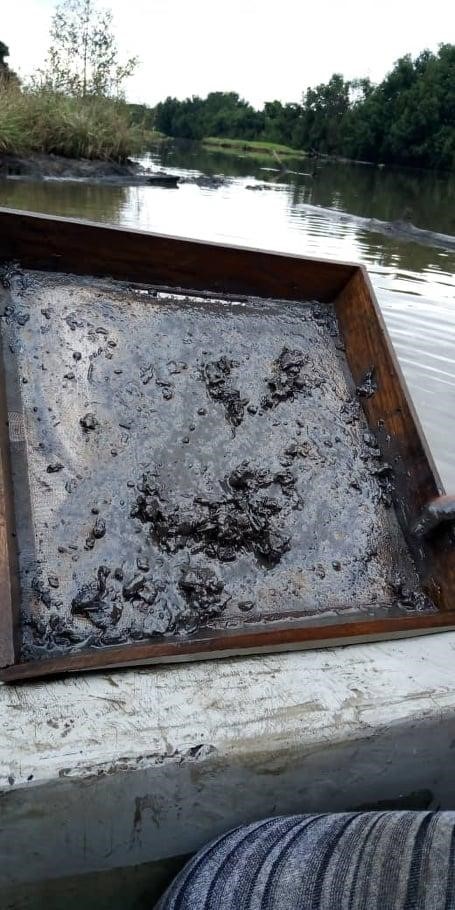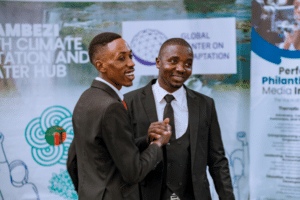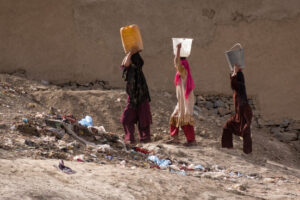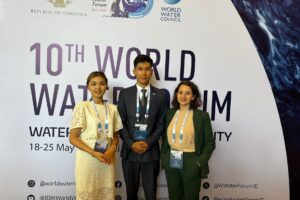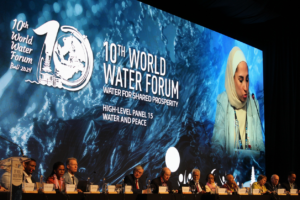Description
Dear participants,
Over the past 5 days, you all had the opportunity to learn about the most pressing water-related issues from leading experts and representatives from relevant organizations from around the world. You all worked on concrete initiatives with young leaders and professionals who share similar interests as you do. And amidst all the learning and networking, we hope you managed to have fun as well, just as much as we did organizing the event.
But after 18 intriguing parallel sessions, 2 interactive networking sessions, 5 working groups, and opening and closing ceremonies, we have come to the end of the 5th General Assembly of the World Youth Parliament for Water. This was the first time the General Assembly was held online, and we are pleased to say that it all went smoothly, thanks largely in part to your active participation and support. Kudos! Our virtual hats are off to you.
We had a fitting end to the week with an eventful Day 5. Two immersive talks in the parallel session and the wonderful closing ceremony provided an apt conclusion to the eventful week. More details below.
PARALLEL SESSIONS RECAP
The last day of the General Assembly featured parallel sessions that explored water solutions at different scales. Participants had the opportunity to learn about youth-led initiatives at the local level and the challenges of scaling up as well as advances in water resource management based on Earth observations.
DAY 4
FOCUS ASIA: CHALLENGES OF INVOLVING THE STAKEHOLDERS IN WATER-RELATED QUESTIONS
Host: Central Asia Youth for Water (CAY4W)
By Janeth Morales E.
The session explored the role of stakeholders in water-related issues in the Central Asian context, focusing on the importance of better and effective communication, coordination, and implementation in turning existing challenges into opportunities for better involvement and stronger action. Challenges to women’s participation in community-level water-related projects were also discussed. The talk was hosted by Lyazzat Syrlybayeva, Cholpon Aitakhunova, and Umidkhon Uzbekov of Central Asia Youth for Water (CAY4W) and featured presentations from Olivier Normand of the International Secretariat for Water (ISW) and Shohlda Tulleva of the Syr-Darya Basin Women Forum of Tajikistan.
The longest river in Central Asia, the Syr Darya River, crosses six countries – originating in Kyrgyzstan and Uzbekistan and flowing through Uzbekistan and Kazakhstan to the northern remnants of the Aral Sea. Most inhabitants in the region do not have access to treated water or can only get water from unimproved water sources. In many villages, the inhabitants have no other choice than to consume unsafe water from irrigation channels or else to buy water of dubious quality carried in tank trucks.
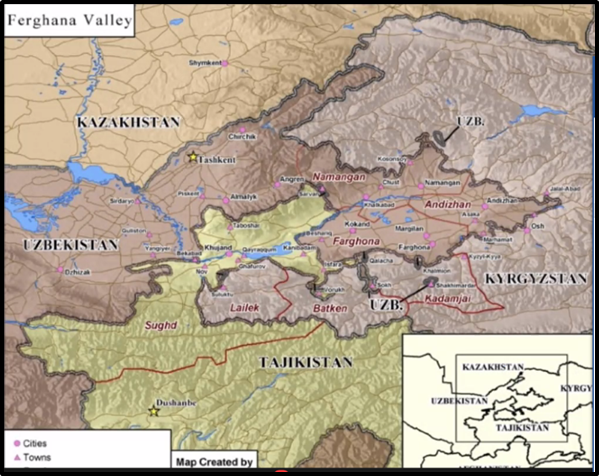
To improve the living and health conditions at the community level in the Andijan, Ferghana, and Namangan provinces of the Ferghana Valley, Mr. Normand explained that the ISW, financed by the Swiss Agency for Development and Cooperation, developed a project to strengthen decentralized water supply services and improve hygiene and sanitation practices. After more than 15 years during which 160,000 inhabitants in Uzbekistan and Tajikistan gained affordable water services, the community-led approach to water management was officially adopted by Uzbek authorities and extended throughout the country. Mr.Normand stressed the fundamental role of the participation of the local population in the development and management of the sustainable decentralized multi-village water systems. Local communities, represented by a village general assembly, a management board, and a revision committee, were willingly involved from the project’s conception and, with the support of independent drinking water associations that were provided technical support and organizational know-how, have gained an understanding and appreciation for water supply services and infrastructure. The comprehensive handwashing promotion campaign for school children was combined with the training of healthcare workers and was effective in propagating the message of the importance of hygienic practices, particularly in reducing water-borne diseases.
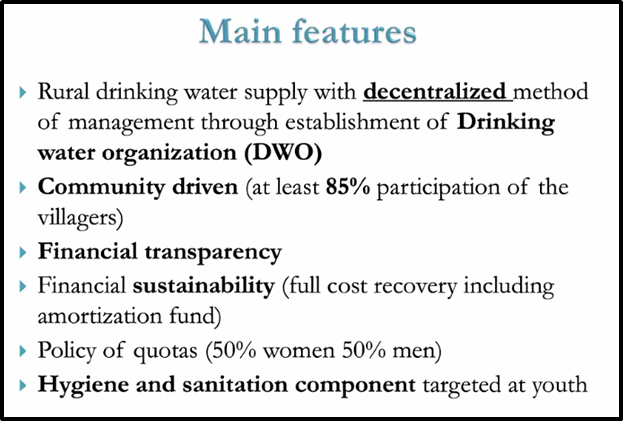
Ms. Tulleva introduced the Syr Darya Basin Women Forum as a platform that was created within the framework of the National Project of Water Resources Management in Tajikistan to represent women’s voices. With the goal of increasing the livelihood of populations in the Pyanj basin, the project has been implemented by national, basin, and local level working water associations, farmers, and populations. She went on to explain that when projects are initiated by local partners they must ask, “How can women be involved in the project?”. A lack of leadership, low level of education, and low self-esteem were identified from the discussions of working groups in which men and more than 3000 women participated as the main barriers to women’s involvement in water-related projects and were attributed to tradition, customs, or rules that limit their participation, particularly with women under 35 years. However, older women were said to be more vocal and skilled.
VALUING LOW TECH SANITATION IN THE AMERICAS
Host: Point of shift
By Janeth Morales E.
The session sought to promote the use of low-tech sanitation solutions in improving access to sanitation, particularly in the Americas. Low-tech sanitation technologies were introduced and obstacles to adoption addressed. Discussions were led and facilitated by Kelsey Mc Williams of Point of Shift; Jasmine Burton, the executive director of Wish for Wash; the founder of FLUSH, Kimberly Worsham; Julie Waechter and Al Smith of DIGDEEP Water; and the founder of Coletivo GRITO, Paulo Shinji.
Initial talks centered around defining low-tech sanitation solutions. Ms. Williams defined low-tech sanitation as sanitation systems or solutions that are limited for nature (nutrients are returned to the soil as compost). Ms. Worsham and Ms. Burton stated that in addition low-tech sanitation systems are affordable compared to high-tech solutions and designed to have low energy and water requirements, and be low-maintenance, accessible, available, and intuitive. Mr. Shinji also commented that low-tech sanitation should not be restricted to rural settings as its design is dependent on regional characteristics that vary with natural processes. Apart from the regional context, he also identified scales, values, and innovation as aspects to be considered when designing low-tech solutions. Moreover, Ms. Waechter explains that whatever low-technology sanitation is created, it should be designed according to the lifestyles of the end-user (individuals working full-time, lower financial resources, lower incomes) and it should be valued by the inhabitants.
After characterizing low-tech sanitation solutions, the conversation transitioned to discussing the need for low-tech sanitation solutions and how these technologies could be more valued by users. Mr. Smith explained that local communities really need this low-technology sanitation as opposed to centralized sewerage systems which are inappropriate, expensive, infeasible. Therefore the capacity of low-technology sanitation should be increased or combined with other technologies and its applicability as decentralized systems assessed. The value of low-tech sanitation solutions can be promoted if its ease of use, application at point use, and ability to capture nutrients as compost that can be used in gardens or sold as natural fertilizer is marketed. Their use also can help maintain public health and preserve the dignity of users. To increase value for low-tech sanitation in local communities, Ms. Worsham added that the development and implementation of the solutions should ensure community members are involved and allow persons to ask questions via participatory events or meetings. It is necessary that populations feel comfortable to start conversations with other stakeholders. It was also recommended that relevant public health Information be communicated to the end-users through social media as well as sanitation platforms.
ON THE ROAD TO COP26: WATER AND CLIMATE
Host: YOUNGO
By Syed Nasar Alam
The session titled “On the road to COP26: Water and Climate” was moderated by Heeta Lakhni featuring speakers such as Luciana Raquel Verástegui Moncada and Luis Carlos Morillo Rodriguez of YOUNGO, Emma Grace Wilkinson of Global Choices Arctic Angels, and Marie-Claire Graf, a UN Framework Convention on Climate Change (UNFCCC) Youth Delegate. The session discussed two of the most prominent water bodies impacted by climate change, oceans, and arctic sea ice.
The session started with a joint presentation introducing YOUNGO from Ms. Moncada and Mr. Rodriguez. While mentioning other affiliated organizations, Ms. Moncada encouraged participants to become engaged in any organization tackling similar objectives, stressing that “it doesn’t matter what you like or where you live but you can be part of the solution and be part of the change”. Elaborating on her activity with Ocean’s Voice, a working group of YOUNGO, Ms. Moncada explained the importance and shared nature of oceans and their relation to climate change through the sequestering and storing of “blue carbon” from the atmosphere and ocean in plants and sediments of coastal and marine ecosystems. In contrast, Mr. Rodriguez spoke of eutrophication, a threat to the health of marine ecosystems, and the initiatives Ocean’s Voice were engaged in internationally to address it.
The third speaker, Emma Grace Wilkinson, belonged to Arctic Angel, a youth-led non-profit organization. Ms. Wilkinson led with detailing the “ice crisis” that is occurring in the polar regions. In 2020, the low sea ice levels were second only to the record low of September 2012. Ms. Wilkinson warned that “the impact of the ice loss is immediate” and increases exponentially from the local to global scale. Wildfires are also a concern as “arctic wildfires set the pollution world record, emitting 56 megatonnes of CO2” in June of 2020. Keeping this in mind, COP26 was framed as “our last chance to make concrete action happen in this decade”. Ms Graf then explained the work of Arctic Angels and their commitment to protecting our global commons, resources that do not fall within the jurisdiction of any one particular country, and to which all nations have access.
Later, participants were split into 2 interactive breakout sessions that were led by the speakers to discuss water, climate, and youth engagement as it relates to either the oceans or the arctic region. Among the takeaways from the breakout sessions was the understanding that “young people can get policymakers to make decisions if they join together”.
DAY 5
WATER INNOVATION FROM SPACE
Host: NASA
By Prabhat Joshi
This session, entitled ‘Water Innovation from Space’ was moderated by Ms. Shanna McClain (NASA), and included insightful talks on remote sensing applications for earth observations, mostly in the context of the water sector. The featured speakers included two NASA scientists: Dr. Iliana E. Mladenova and Dr. Amber Jenkins.
Dr. Mladenova kicked off the session with an introduction to the application of hydrological models and remote sensing techniques to monitor hydrological processes (namely, assessing soil moisture content). “There are a plethora of models available today but the models are only as good as the input data they are provided with”, said Dr. Mladenova, “and what the end-users gain from the model results is the most important question of all”. She related the significance of model results to a farmer who would want to know about soil water availability for crop production or to determine the extent or timing of irrigation. She also touched upon active and passive remote sensing techniques, leading to an introduction of satellite-derived Soil Moisture Active Passive (SMAP) mission. An example of drought monitoring in South Africa was presented to illustrate a case for the use of surface soil moisture product that was derived by integrating SMAP retrievals into the modified two-layer soil moisture model.
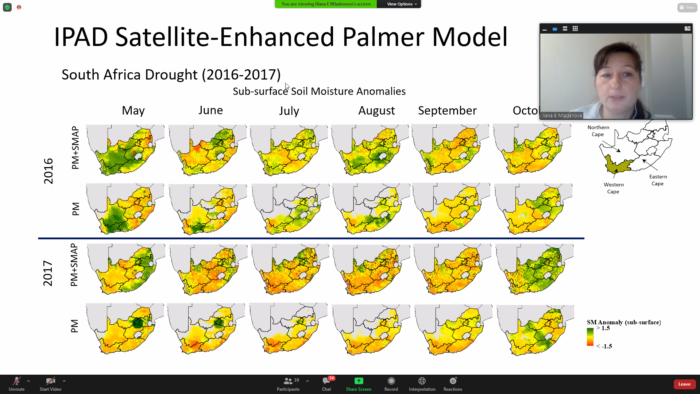
Dr. Amber Jenkins continued with the second talk of the session that covered the details of how NASA’s Western Water Applications Office has been applying its resources, knowledge, and data to real-world use. She presented five key points: (1) The power of perspective: how NASA’s earth observations provide invaluable images and results that provide an important perspective on various terrestrial and hydro-meteorological phenomena occurring across the globe; (2) Science to action: detailing upon how NASA acquired data, tools, and technologies can be used to gain insights to improve water use; (3) Building partnerships: on the significance of engaging with stakeholders and end-users to really know and understand what they need; (4) Delivering solutions: on how the stakeholders and end-users need to be brought into the fold at the very beginning of the project to ensure that they can use the technology independently; and (5) Impact and transition: on how the continuous feedback and regular monitoring can help sustain a project’s impact.
“Our history is written in water. Our future will be, too”, said Dr. Jenkins, “Together we are writing the future of the planet. Let’s work together to write an improved one.”
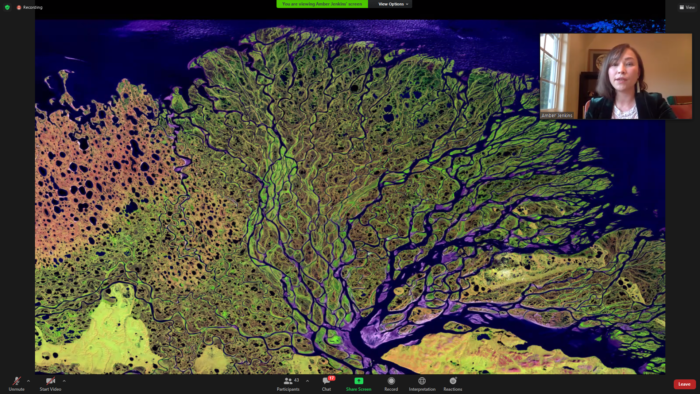
CLOSING CEREMONY
By Raheem Smith
The 5th World Youth Parliament for Water General Assembly came to a refreshing end with a closing ceremony held on March 26th. Over 600 participants signed up for the General Assembly which, for the first time, was held online. From Monday to Friday participants were able to enjoy workshops, networking sessions and webinars.
During the closing ceremony the outgoing executives of the parliament – Outgoing President Lindsey Aldaco-Manner (2018 – 2021) and her Vice President Alex White Brook (2018 – 2021) – handed over the leadership to the incoming female duo of Incoming President, Carolina Tornes Mac Kinnon, and her Vice President Danielle Kamtie. Incoming president Carolina Tornesi Mac Kinnon addressed the assembly with her inaugural speech and thanked the sponsors and partners. “We are the leaders of tomorrow and I believe that we can and will change the world”. The first portion of the ceremony ended with the Rapporteur Working Group presenting a video of highlights from the different sessions of the week.
The second half of the closing ceremony included presentations from Kasha Slavner of the Global Sunrise Project and Mr. Manuel Fulchiron of the International Secretariat for Water. In her address, Ms. Slavner emphasised the need for cross-sector collaboration by stating that, “We need everybody across sectors to unify for change”. Mr. Fulchiron expressed his appreciation for the outgoing executive and welcomed the incoming executive and the regional representatives. To close, the incoming vice president of WYPW Danielle Kamtie thanked all participants and speakers. She also reminded participants that if interested, they can sign up to become a member of the parliament.
WORKING GROUP ACTIVITIES RECAP
WORKING GROUP 2: INNOVATION AND LOCAL ACTION
By Ransford O.Tetteh
The working group 2 (Innovation and local action) aimed to provide engaged youth with relevant skills to develop innovative ideas for a more sustainable and water-secure world. The group consists of 18 active participants who met four times during the General Assembly. With the exception of the first introductory session, each meeting included three sessions. The hands-on nature of the working group activities inspired members to remain committed to continued participation in hopes of learning how projects can have a bigger impact in communities with different water-related challenges. In one such session members were introduced to the problem tree approach to identify problems at the local level.
The Niger Delta experience
Amarachi (Amara), a lecturer and a WASH youth activist in Delta State of Nigeria, described the poor water supply and sanitation issues bedevilled by the residents as a result of massive oil spills from activities of oil companies in the state. This has repercussions on the quality of water available to residents since most of their source is from nearby water bodies. Amara shared that through a feasibility study pollutants like oil, and heavy metals like iron and lead which are toxic to life, both aquatic and human, were identified. She indicated that, “through bioaccumulation, consumption of fish can endanger your life”. She cautioned against willful ignorance. “It’s a collective call” she said, “we must all contribute in fighting this”.
According to Amara, some of the barriers facing the fight include, inter alia, lack of funding for research, lack of political will, and non-enforcement of policies by the government. As part of initiatives to address the challenges, Amara, together with her students, occasionally cleans up the surface of the water body. She, however, admitted that action alone is not enough when considering the extent of pollution by chemicals and appealed for funding in conducting ‘meaningful’ research.
